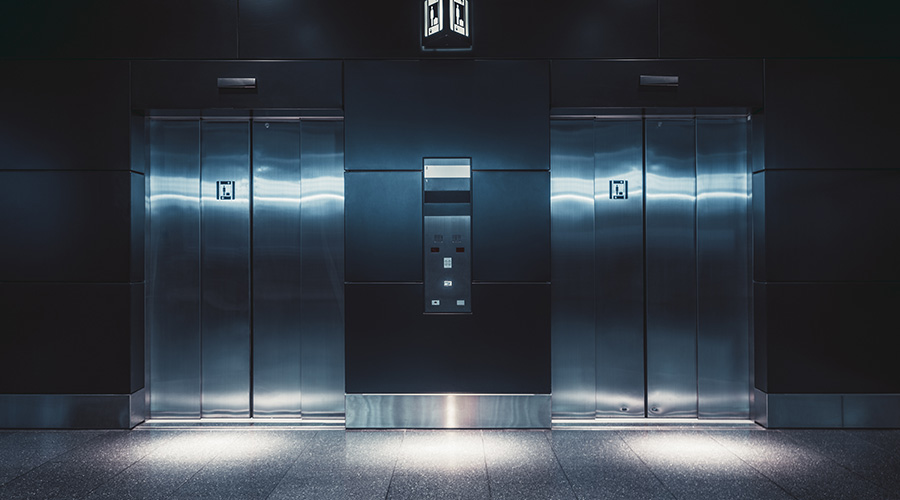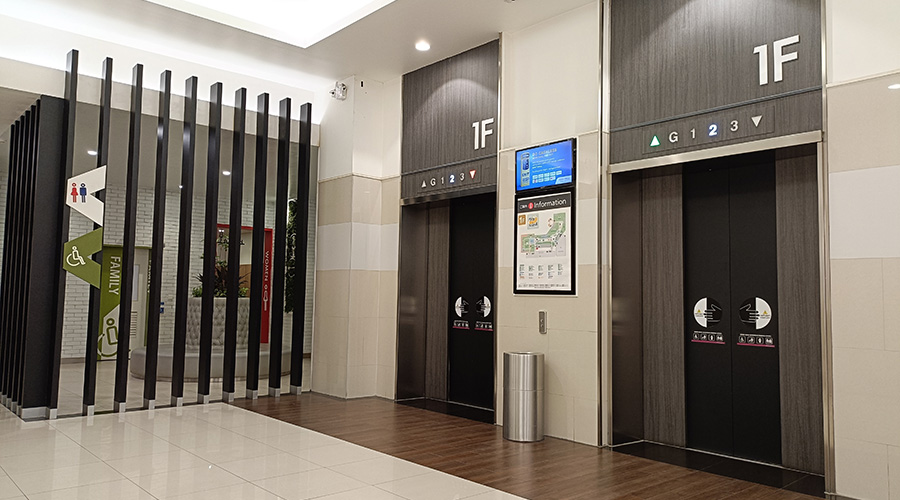Elevators: ROI depends on building owner's ‘ROI’
An owner’s “rate of involvement” is a critical factor in determining how long an elevator system will last, and when it’s time for an upgrade
When talk turns to a hair’s difference in elevator speeds, building owners’ eyes glaze over. All other things being equal, if a competitor’s elevator system’s floor-to-floor times are a few seconds faster, that’s hardly considered competitive advantage.
That doesn’t mean, however, that an owner can ignore the elevator system. Slower performance times, increasing door problems and increasing injury reports are among the early signs that something could be amiss in the elevator system and that its days may be numbered. And if the elevators begin breaking down frequently, that could have a significant impact on an owner’s vacancy rate and tenant base.
Keeping an elevator system, even an older one, in good running order and planning for the next system upgrade take building owner awareness of the system’s operation. As one elevator expert puts it, an owner’s ROI equals ROI — return on investment equals rate of involvement.
Age May be Important
The rule of thumb in the elevator industry is 20 years and out. After 20 to 25 years of service, elevators are probably reaching the end of their cost-effective lives, and building owners should be preparing for a modernization. That rule of thumb is even more important these days because 20 years ago saw a change in technology in elevator systems.
“The mid-’80s was the end of relay-logic control systems,” says Roy Porta, principal with JSG Elevator Consultants. “These systems and the maintenance technicians in charge of fixing them are ready for retirement.”
“Relay-logic controllers did OK in their time, and if properly maintained, they could last a little longer,” says Dennis Chandler, president, Continental Hoisting Consultants Inc. “But manufacturers are starting to phase out parts, so that could be a problem.”
If a building owner still has a relay-logic system in good running order and hasn’t had problems, that’s a tribute to a good preventive maintenance program.
“But don’t be blinded by this,” Chandler says. “There is still the parts issue, and fewer and fewer people know how to work on them.”
Systems installed in the late ’80s filled a transitional niche between old relay-logic systems and the solid-state systems that were beginning to be installed in the 1990s and are popular today. The transitional technology combined the best of the relay-logic systems with some computer-based control systems. Building owners can expect these systems to still provide good service if they have received regular OEM maintenance, Porta says.
The questions then become how much longer will these transitional systems last and what is forfeited in performance and reliability in keeping them longer, he says.
That’s important for building owners, Chandler says, because today’s systems offer many advantages over the relay-logic systems. So finding the right time to upgrade depends in part on a number of issues, including how well the existing elevators were maintained.
Maintenance Key to Life Span
In addition to the age of the system, decreasing performance, increasing service calls or callbacks and increasing downtime are critical indicators of potential problems, says Bill Bell, executive vice president of business development for Lerch, Bates and Associates.
Poor maintenance can age a system before its time. It can lead to parts wearing out sooner or make it more difficult to maintain original equipment design criteria and adjustments. While this is truer of older systems than of newer solid-state ones, all systems require systematic and regular maintenance.
In addition, owners should do periodic traffic analyses. Elevator maintenance technicians can attach a system analyzer to the elevator group control panel to evaluate the current traffic patterns of the existing building population as it relates to the original group performance criteria. This will provide an indication of how adequately the system is meeting occupants’ needs.
One of the first things to measure is how long users are waiting for elevators. A range of 25 to 35 seconds is comfortable for most people in a modern office building. An interest in reducing these times is usually a high priority in a modernization, and an upgrade to a new system could have a significant impact on these times.
It is also critical to do a maintenance audit early in the planning process.
“Look at all the equipment and how it has been maintained, from the machine room to the pit,” Bell says. Check all ADA requirements, including door speeds. Evaluate the actual overall maintenance program and compare it to what was called for in the contract.
The key maintenance areas to making sure any elevator operates best are housekeeping, repair, lubrication and adjustment, Bell says. The most often ignored is the housekeeping or cleanliness of equipment and equipment spaces. The cleanliness of the equipment room — the environment in which the equipment operates everyday — is not only important by itself, but it also may indicate how the maintenance contractor is taking care of the equipment.
“This is especially important for older relay-logic systems,” he says.
Owners should also periodically check all maintenance records or logs. All maintenance technicians should keep detailed maintenance logs, and these logs should be readily available so that work that was done can be compared to what the contract called for.
“While the best maintenance technicians know what they’re doing, it’s important to know when they’re doing it,” Chandler says.
“Building owners should periodically ride the elevator with just the elevator performance in mind,” he says. “See how it’s leveling. Is the ride smooth and quiet? How does the door respond? Are the emergency-response controls working?”
Growing Focus on Safety
One big issue when considering a modernization is safety, especially for elevators with in-ground hydraulic cylinders. These cylinders have been known to rust and lose hydraulic pressure, which sends the cab free-falling.
Now, code requires all in-ground hydraulic elevator cylinders to have PVC linings for corrosion protection. This is true whether the elevator has been retrofitted with a safety device that keeps the cab from falling should there be a loss in hydraulic pressure.
A new hydraulic system without an in-ground cylinder that is just entering the U.S. market is a “rope hydraulic” system. There is no in-ground cylinder, and the elevator acts like a traction elevator with necessary built-in safety devices. It’s more expensive than a traditional hydraulic system but not as expensive to install as a traction elevator.
Safety is becoming a legal issue taken up in the courts, and building owners are being held to the same standard of care as common carriers, Chandler says.
“Building owners are transporting people vertically but in the same way buses or taxis are moving people horizontally,” Chandler says. “The courts are starting to recognize this, so safety is very important.”
Maintenance Contracts
The maintenance of elevators for most of today’s buildings is contracted out. Making sure owners are getting all they are paying for is serious business.
This raises the question of what is better: a long- or short-term contract. Most consultants favor contracts that are five years at a minimum. But some, such as Porta, believe contracts could be as long as 25 years and serve the owner well.
“What we recommend is to negotiate a long-term maintenance service contract — 20 to 25 years — with cost-of-living caps, so you can hold their feet to the fire if necessary,” he says.
Because manufacturers like to lock in the steady business, long-term contracts give the building owner some leverage with the details. But, he says, the contract should have performance clauses to keep contractors on track.
Others think contracts that long may mean the contractor could become less diligent and may mean greater owner responsibility to enforce the contract. Chandler prefers a contract of five years that is renewed annually.
“This gives the building owner maximum flexibility,” he says. “If he doesn’t like the service, he can shop around, and the contractor knows this.”
Unfortunately, scope and breadth of the contract are partially dictated by the marketplace, Bell says. A tough competitive market could provide the owner some flexibility, whereas one dominated by one or two manufacturers could hurt owners unless they are very careful.
But it’s not just the length. How the contract is structured is critical. Manufacturers are now starting to employ usage-based contracts, Bell says. Owners should consider their implications versus full-service contracts.
“A usage-based contract may be appropriate, but there are some aspects of maintenance that isn’t dependent strictly on usage,” he says. Usage-based agreements can work, but they must be properly structured and supervised.
Although manufacturers may be unlikely to accept a contract with a termination clause, they should be held to a contract that clearly spells out very specific terms and conditions, such as how many callbacks are allowed and what the response time should be. Performance specs should be spelled out in detail in the contract, Chandler says, such as time sequences, using every four weeks rather than monthly.
With a properly maintained elevator system, the decision to modernize becomes a strategic capital investment rather than one done out of necessity. And a properly maintained elevator also means better service, which is good for the owner, and fewer callbacks, which is good for the contractor.
Related Topics:











